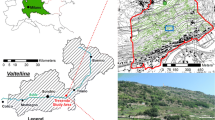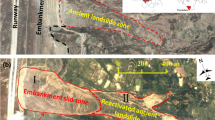Abstract
Slopes that are terraced by means of dry-stone retaining walls are very common in the alpine environment. In Valtellina, a typical Italian alpine valley, these slopes are widespread and quite often involved in superficial mass movements that can result in severe damage and casualties. For an in-depth understanding of the processes that can trigger these events, numerical modeling of groundwater movement and a related stability analysis were performed on a detailed scale, based on an intensive monitoring of rainfall events and groundwater movement. Field observations suggest that the formation of a perched groundwater table at the contact between the bedrock and the backfill soil of walls as well as the concomitant saturation of this backfill soil are the determining factors of potential slope failure. The numerical models support these observations. In addition, the models are able to explain the mechanisms of formation of perched water tables, highlighting the factors that can influence groundwater levels and slope instabilities.












Similar content being viewed by others
References
Agostoni S, Laffi R, Sciesa E (1997) Centri abitati instabili della provincia di Sondrio. CNR-GNDCI, Milano, pp 59 + Annexes
Apip, Takara K, Yamashiki Y, Sassa K, Ibrahim AB, Fukuoka H (2010) A distributed hydrological-geotechnical model using satellite-derived rainfall estimates for shallow landslide prediction system at a catchment system. Landslides 7:237–258. doi:10.1007/s10346-010-0214-z
ASTM (2004) Standard test method for direct shear test of soils under consolidated drained conditions. American Society for Testing and Materials D3080–04
ASTM (2006) Standard test method for permeability of granular soils (constant head). American Society for Testing and Materials D2434–06
ASTM (2007) Standard test method for density and unit weight of soil in place by the sand-cone method. American Society for Testing and Materials D1556–07
ASTM (2010) Standard practice for classification of soils for engineering purposes (Unified Soil Classification System). American Society for Testing Materials D2487–10
Azzola M, Tuia T (1983) Osservazione sui fenomeni franosi che hanno interessato i vigneti terrazzati a monte di Tresenda nel maggio 1983. Geologia Tecnica, Ed. Ordine Nazionale dei Geologi, Rome, Italy 4:23–35
Bacchini M, Zannoni A (2003) Relations between rainfall and triggering of debris-flow: case study of Cancia (Dolomites, Northeastern Italy). Nat Hazards Earth Syst Sci 3:71–79
Beltrami G, Bianchi A, Bonsignore G, Callegari E, Casati P, Crespi R, Dieni I, Gnaccolini M, Liborio G, Montrasio A, Mottana A, Ragni U, Schiavinato G, Zanettin B (1971) Carta Geologica d’Italia alla scala 1:100.000. Foglio 19 Tirano-Servizio Geologico d’Italia
Blahut J, Poretti I, De Amicis M, Sterlacchini S (2012) Database of geo-hydrological disasters for civil protection purposes. Nat Hazards 60(3):1065–1083. doi:10.1007/s11069-011-9893-6
Caine N (1980) The rainfall intensity-duration control of shallow landslides and debris flows. Geogr Ann 62A:23–27
Camera C, Masetti M, Apuani T (2012) Rainfall, infiltration, and groundwater flow in a terraced slope of Valtellina (Northern Italy): field data and modelling. Environ Earth Sci 65(4):1191–1202. doi:10.1007/s12665-011-1367-3
Cancelli A, Nova R (1985) Landslides in soil debris cover triggered by rainstorms in Valtellina (Central Alps, Italy). In: Proceedings of the IV International Conference and Field Workshop on Landslides, Tokyo, August 1985, pp 267–272
Ceriani M, Lauzi S, Padovan N (1992) Rainfalls and landslides in the alpine area of Lombardia Region, Central Alps, Italy. In: Internationales Symposion Interpraevent. Bern (Switzerland), 1992, Band 2, pp 9–20
Choi J, Oh HJ, Won JS, Lee S (2010) Validation of an artificial neural network model for landslide susceptibility mapping. Environ Earth Sci 60:473–483. doi:10.1007/s12665-009-0188-0
Corominas J, Moya J (1999) Reconstructing recent landslide activity in relation to rainfall in the Llobregat River basin, Eastern Pyrenees, Spain. Geomorphology 30:79–93. doi:10.1016/S0169-555X(99)00046-X
Crosta GB (1990) A study of slope movements caused by heavy rainfall in Valtellina (July 1987). In: Proc. 6th International Conference and Field Workshop on Landslides, Milan, pp 247–258
Crosta GB, Frattini P (2001) Rainfall tresholds for triggering soil slips and debris flow. In: Proceedings of EGS 2nd Plinius Conference 2000, Mediterranean Storms, Siena, pp 463–488
Crosta GB, Dal Negro P, Frattini P (2003) Soil slips and debris flows on terraced slopes. Nat Hazards Earth Syst Sci 3:31–43
Crozier MJ (1999) Prediction of rainfall-triggered landslides: a test of the antecedent water status model. Earth Surf Process Land 24:825–833. doi:10.1002/(SICI)1096-9837(199908)24
Dahal RK, Hasegawa S, Nonomura A, Yamanaka M, Masuda T, Nishino K (2008) GIS-based weights of evidence modelling of rainfall-induced landslides in small catchments for landslide susceptibility mapping. Environ Geo 54:311–324. doi:10.1016/j.geomorph.2008.05.041
Fleming RW, Ellen SD, Algus MA (1989) Transformation of dilative and contractive landslide debris into debris flows—an example from Marin County, California. Eng Geol 27:201–223. doi:10.1016/0013-7952(89)90034-3
Fredlund DG, Rahardjo H (1993) Soil mechanics for unsaturated soils. Wiley, New York
GEO-SLOPE International Ltd. (2002a) SEEP/W user’s guide, version 5. Calgary
GEO-SLOPE International Ltd. (2002b) SIGMA/W user’s guide, version 5. Calgary
Gosso G, Spalla MI, Bini A, Siletto GB, Berra F, Forcella F, Cariboni M, Corbari D, Ferliga C, Gazzola D, Rodeghiero F, Tognini P (2012) Carta Geologica d’Italia alla scala 1:50.000. Foglio 057 Malonno – Istituto Superiore per la Protezione e la Ricerca Ambientale, Servizio Geologico d’Italia (in press)
Govi M, Mortara G, Sorzana PF (1985) Eventi idrologici e frane. Geol Appl e Idrog 20(2):359–375
Guzzetti F, Crosta G, Marchetti M, Reichenbach P (1992) Debris flows triggered by the July, 17–19, 1987 storm in the Valtellina area (Northern Italy). In: International Symposium Interpraevent 1992, Bern, Switzerland, pp 193–203
Guzzetti F, Perruccacci S, Rossi M, Stark CP (2008) The rainfall intensity-duration control of shallow landslides and debris flows: an update. Landslides 5:3–17. doi:10.1007/s10346-007-0112-1
Harkness RM, Powrie W, Zhang X, Brady KC, O’Reilly MP (2000) Numerical modeling of full-scale tests on drystone masonry retaining walls. Geotechnique 50(2):165–179. doi:10.1680/geot.2000.50.2.165
Hungr O, Evans SG, Bovis MJ, Hutchinson JN (2001) A review of the classification of landslides of the flow type. Environ Eng Geosci 7(3):221–238
Hungr O, Leroueil S, Picarelli L (2012) Varnes classification of landslide types, an update. In: Eberhardt E, Froeses C, Keith Turner A, Leroueil S (eds) Landslides and engineered slopes. Protecting society through improved understanding, vol 1. CRC Press, London, pp 47–58
Ibsen ML, Casagli N (2004) Rainfall patterns and related landslide incidence in the Porretta-Vergato region, Italy. Landslides 1:143–150. doi:10.1007/s10346-004-0018-0
Itasca Consulting Group, Inc. (2008) FLAC Version 6.00. User’s guide, 4th edn. Minneapolis
Iverson RM, Reid ME, LaHusen R (1997) Debris-flow mobilization from landslides. Annu Rev Earth Planet Sci 25:85–138
Jacob M, Holm K, Lange O, Schwab JW (2006) Hydrometeorological thresholds for landslide initiation and forest operation shutdowns on the north coast of British Columbia. Landslides 3(3):228–238. doi:10.1007/s10346-006-0044-1
Jakob M, Lambert S (2009) Climate change effects on landslides along the southwest coast of British Columbia. Geomorphology 107:275–284. doi:10.1016/j.geomorph.2008.12.009
Johnson AM, Rahn PH (1970) Mobilization of debris flows. In: Macar P (ed) New contributions to slope evolution. Zeitschrift für Geomorphologie Neue Folge. Supplementband, vol 9 (pp 168–186)
Khan YA, Lateh H, Baten MA, Kamil AA (2011) Critical antecedent rainfall conditions for shallow landslides in Chittagong City of Bangladesh. Environ Earth Sci. doi:10.1007/s12665-011-1483-0
Kuriakose SL, van Beek LPH, van Westen CJ (2009) Parameterizing a physically based shallow landslide model in a data poor region. Earth Surf Process Land 34:867–881. doi:10.1002/esp.1794
Lee S, Pradhan B (2007) Landslide hazard mapping at Selangor, Malaysia using frequency ratio and logistic regression models. Landslides 4:22–41. doi:10.1007/s10346-006-0047-y
Lourenço PB, Oliveira DV, Roca P, Orduña A (2005) Dry joint stone masonry walls subjected to In-Plane combined loading. J Struct Eng 131(11):1665–1673. doi:10.1061/(ASCE)0733-9445(2005)131:11(1665
Luino F, Nigrelli G, Biddoccu M, Cirio CG, Di Palma M, Missaglia M, Fassi P (2008) Definizione delle soglie pluviometriche d´innesco di frane superficiali e colate torrentizie: accorpamento per aree omogenee. IRER, Milano
Montrasio L, Valentino R, Losi GL (2009) Rainfall-induced shallow landslides: a model for the triggering mechanism of some case studies in Northern Italy. Landslides 6:241–251. doi:10.1007/s10346-009-0154-7
Powrie W, Harkness RM, Zhang X, Bush DI (2002) Deformation and failure modes of drystone retaining walls. Geotechnique 52(6):435–446. doi:10.1680/geot.2002.52.6.435
Pradhan B, Lee S (2010) Regional landslide susceptibility analysis using back-propagation neural network model at Cameron Highland, Malaysia. Landslides 7:13–30. doi:10.1007/s10346-009-0183-2
Quan Luna B, van Westen CJ, Blahut J, Camera C, Apuani T, Sterlacchini S (2010) From deterministic hazard modelling to risk and loss estimation. In: Mountain Risks: Bringing Science to Society. Proceedings of the International Conference, 24–26th November 2010, Florence, Italy. CERG Editions, Strasbourg, pp 373–380
Rahardjo H, Li XW, Toll DG, Leong EC (2001) The effect of antecedent rainfall on slope stability. Geotech Geol Eng 19:371–399. doi:10.1023/A:1013129725263
Revellino P, Guadagno FM, Hungr O (2008) Morphological methods and dynamic modeling in landslide hazard assessment of the Campania Apennine carbonate slope. Landslides 5:59–70. doi:10.1007/s10346-007-0103-2
Salciarini D, Godt JW, Savage WZ, Conversini P, Baum RL, Michael JA (2006) Modeling regional initiation of rainfall-induced shallow landslides in the eastern Umbria Region of central Italy. Landslides 3:181–194. doi:10.1007/s10346-006-0037-0
Simoni S, Zanotti F, Bertoldi G, Rigon R (2008) Modelling the probability of occurrence of shallow landslides and channelized debris flows using GEOtop-FS. Hydrol Process 22:532–545. doi:10.1002/hyp.6886
Tsai TL (2008) The influence of rainstorm pattern on shallow landslide. Environ Geol 53:1563–1569. doi:10.1007/s00254-007-0767-x
Tsai TL, Chen HE, Yang JC (2008) Numerical modeling of rainstorm-induced shallow landslides in saturated and unsaturated soils. Environ Geol 55:1269–1277. doi:10.1007/s00254-007-1075-1
van Beek LPH, van Asch TWJ (2004) Regional assessment of the effects of land-use change on landslide hazard by means of physically based modelling. Nat Hazards 31:289–304
Villemus B, Morel JC, Boutin C (2007) Experimental assessment of dry retaining wall stability on a rigid foundation. Eng Struct 29:2124–2132. doi:10.1016/j.engstruct.2006.11.007
Walker P, McCombie P, Claxton M (2007) Plane strain numerical model for drystone retaining walls. Geotech Eng 160(GE2):97–103. doi:10.1680/geng.2007.160.2.97
Zezere JL, Trigo RM, Trigo IF (2005) Shallow and deep landslides induced by rainfall in the Lisbon region (Portugal): assessment of relationships with the North Atlantic Oscillation. Nat Hazard Earth Syst Sci 5:331–344. doi:10.5194/nhess-5-331-2005
Zhang X, Koutsabeloulis NC, Hope S, Pearce A (2004) A finite element analysis for the stability of drystone masonry retaining walls. Geotechnique 54(1):57–60
Acknowledgments
We would like to thank the Comunità Montana Valtellina di Tirano and in particular Giovanni Di Trapani and Alessandro Gervasini for their support during many phases of the work, as well as Alessio Conforto. Thanks also to geologist Maurizio Azzola, who kindly answered every question about the events of 1983, and shared his material with us. The authors would also like to thank the anonymous reviewers for their valuable comments and suggestions that helped to improve the original version of the manuscript.
Author information
Authors and Affiliations
Corresponding author
Rights and permissions
About this article
Cite this article
Camera, C.A.S., Apuani, T. & Masetti, M. Mechanisms of failure on terraced slopes: the Valtellina case (northern Italy). Landslides 11, 43–54 (2014). https://doi.org/10.1007/s10346-012-0371-3
Received:
Accepted:
Published:
Issue Date:
DOI: https://doi.org/10.1007/s10346-012-0371-3




